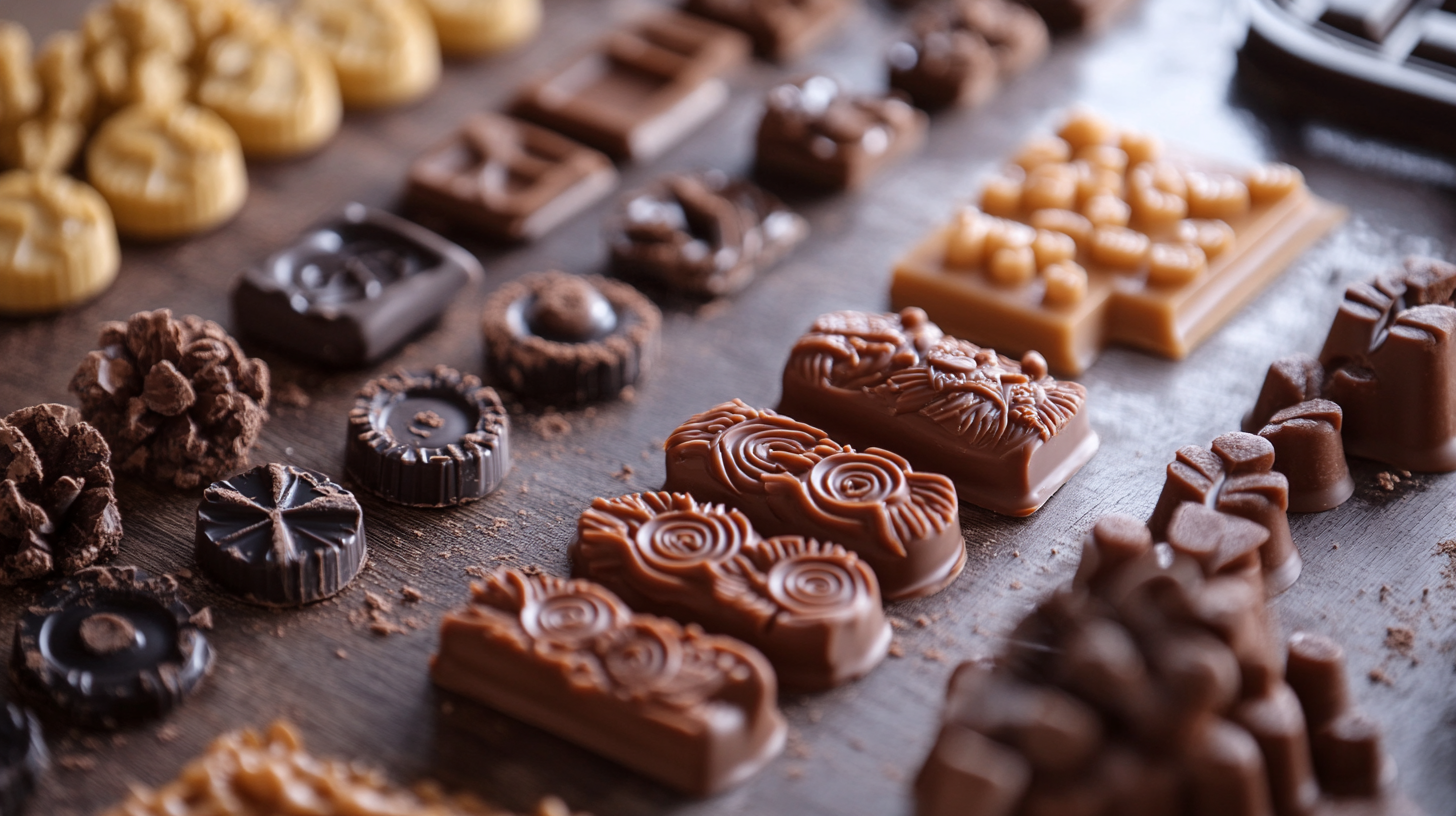Essential Techniques for Optimizing Chocolate Molding Machine Performance
In the world of confectionery manufacturing, the chocolate molding machine plays a pivotal role in shaping and delivering high-quality chocolate products to consumers. As the demand for delicious and innovative chocolate confections continues to rise, optimizing the performance of these machines has become increasingly critical. Properly maintained and efficiently operated chocolate molding machines can significantly enhance production speed, improve product consistency, and reduce waste, ultimately leading to increased profitability for manufacturers.
This blog will explore essential techniques for maximizing the performance of chocolate molding machines, ensuring that they operate at their best. From calibration and maintenance practices to understanding the importance of ingredient quality and machine settings, every aspect contributes to achieving optimal results. Whether you are a seasoned manufacturer or just starting in the chocolate industry, mastering these techniques is crucial for enhancing productivity and creating top-notch chocolate products that captivate the market.

Key Factors Influencing Chocolate Molding Machine Efficiency and Yield
Optimizing the performance of chocolate molding machines is crucial for enhancing efficiency and yield in chocolate production. Key factors influencing these metrics include machine calibration, material temperature consistency, mold design, and maintenance practices. According to industry reports, properly calibrated machines can reduce production times by up to 20%, allowing manufacturers to increase output without compromising quality. Temperature control is another vital aspect when molding chocolate. Chocolate should be maintained at specific temperatures to ensure optimal flow and filling of molds. Data indicates that molds filled at the ideal temperature range of 30-32°C can enhance demolding times and improve the final product's aesthetic appeal. Furthermore, maintaining a consistent material temperature can prevent issues like air entrapment, which can lead to defects and yield loss. The design of the molds also plays a significant role in the efficiency of chocolate production. Advanced mold designs that promote better flow and reduce cooling time can positively impact yield. Recent studies suggest that investing in high-quality, innovative molds can lead to up to a 15% improvement in production yield. Lastly, regular maintenance and timely servicing of molding machines are essential to avoid downtimes, ensuring that the machines run at peak efficiency and reducing the cost associated with production halts.

Advanced Temperature Control Methods for Optimal Chocolate Flow
Optimizing the performance of chocolate molding machines is crucial for manufacturers aiming to ensure quality and consistency in their products. One of the key aspects of achieving this optimization lies in advanced temperature control methods that directly affect chocolate flow. Effective temperature regulation not only ensures the fluidity needed for molding but also plays a significant role in maintaining the integrity and flavor profile of the chocolate.
Recent studies have highlighted the importance of precise temperature control in chocolate processing. For example, research indicates that maintaining a temperature range between 30°C to 32°C during the molding process can significantly enhance the flow characteristics of chocolate, leading to improved mold filling and reduced defects. Furthermore, advanced temperature control systems integrated into molding machines allow for real-time adjustments, ensuring that the chocolate remains within the optimal temperature range throughout production.
Innovations in chocolate processing technology, such as cold extrusion techniques in 3D printing, also reflect a shift towards more efficient temperature management. These methods bypass the need for extensive temperature control by using a different extrusion process. This aligns with findings in the cocoa drying technologies review, which emphasizes the importance of maintaining quality parameters in chocolate production. Implementing these advanced techniques not only aids in achieving superior product quality but also enhances overall production efficiency, which is critical in today’s competitive market.

Innovative Mold Design Techniques to Enhance Production Consistency
Innovative mold design techniques play a crucial role in enhancing the performance of chocolate molding machines, ultimately leading to improved production consistency. A well-designed mold not only influences the final product's quality but also affects the efficiency of the entire molding process. By adopting advanced materials and engineering solutions, manufacturers can create molds that optimize heat distribution, reduce cycle times, and minimize defects.
One effective technique involves the use of temperature control systems integrated within the molds. These systems ensure uniform heating and cooling, preventing issues like uneven chocolate setting or surface defects. Innovations such as silicone or composite molds can also enhance flexibility and durability, allowing for more intricate designs without sacrificing productivity. Furthermore, 3D printing technology is paving the way for custom mold designs that cater to specific production needs, promoting versatility in product offerings while maintaining consistency across batches.
In addition to the physical design of the molds themselves, attention should be paid to the release agents used in conjunction with them. Utilizing the right release agents can significantly decrease the likelihood of chocolate sticking, thereby preserving mold integrity and ensuring smoother production flows. As companies continue to refine their mold designs, these innovative approaches will lead to heightened efficiency and product quality, solidifying their position in a competitive market.

Impact of Cycle Time on Chocolate Quality and Machine Longevity
Cycle time is a critical factor in the chocolate molding process, significantly influencing both the quality of the final product and the longevity of the chocolate molding machine. When cycle times are optimized, manufacturers can achieve a perfect balance between production efficiency and product quality. A shorter cycle time can boost output, but it may come at the risk of compromising the chocolate's texture and taste. It is essential to strike a balance where the chocolate is sufficiently cooled and set before removal from the mold, ensuring that the end product meets high standards.
Moreover, the longevity of the molding machine hinges on proper cycle time management. Rapid cycling can lead to overheating and increased wear-and-tear on machinery components, resulting in costly repairs and downtime. By carefully monitoring and adjusting cycle times, manufacturers can reduce mechanical strain and prolong the life of their equipment. Implementing advanced temperature control and cooling systems can further enhance output without sacrificing quality, making it possible to achieve high production volumes while maintaining the integrity of the chocolate.
Ultimately, understanding the intricate relationship between cycle time, chocolate quality, and machine longevity is crucial for any manufacturer looking to optimize their chocolate molding processes. By focusing on these parameters, companies can enhance both productivity and product excellence, ensuring a successful and sustainable operation.
Regular Maintenance Practices to Maximize Molding Machine Productivity
Regular maintenance practices play a pivotal role in maximizing the productivity of chocolate molding machines. According to data from a recent reliability-centered maintenance study, improper maintenance can lead to a 20-30% reduction in machine efficiency, resulting in significant production losses in the chocolate manufacturing industry. Implementing a structured maintenance schedule can not only extend the lifespan of the molding equipment but also ensure optimal performance during peak manufacturing periods.
One essential technique in maintenance is the routine inspection of key components such as the heating system, conveyor belts, and mold alignment. Industry reports indicate that nearly 40% of molding machine issues stem from misalignment or wear in these critical areas. By conducting regular inspections and addressing these problems proactively, manufacturers can enhance operational efficiency and reduce the likelihood of costly unscheduled downtimes.
Moreover, implementing a predictive maintenance approach can further optimize performance. This method utilizes data analytics and machine learning to foresee potential failures before they occur. According to a survey, companies that adopted predictive maintenance saw a 25% increase in equipment uptime and a 20% reduction in maintenance costs. By focusing on both regular upkeep and advanced monitoring techniques, chocolate manufacturers can ensure their molding machines operate at peak performance, ultimately leading to increased production rates and higher-quality products.
